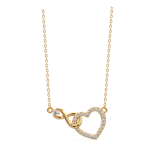Best Way to Clean Oxidised Jewellery: Easy Tips for a Sparkling Shine
Jewellery is more than just an accessory; it carries stories, emotions, and style. But over time, many pieces lose their shine due to oxidation, leaving them looking dull or tarnished. If you’ve been wondering the best way to clean oxidised jewellery at home without damaging it, you’re in the right place.
In this post, we’ll walk through effective methods to restore that lost sparkle and share why investing in KYMEE’s 18K Gold Vermeil Jewellery for women can save you the hassle of frequent cleaning.
Understanding Jewellery Oxidation
What Causes Jewellery to Oxidise?
Oxidation occurs when metals react with oxygen, moisture, or chemicals in the air. Everyday factors like perfume, sweat, lotions, and even the air we breathe can accelerate tarnishing.
Common Metals Prone to Oxidation
- Silver – Tarnishes quickly, developing a blackish hue.
- Copper and Brass – Prone to greenish oxidation.
- Low-quality Gold-Plated Jewellery – The thin plating wears off, exposing base metal.
Preparing Your Jewellery Before Cleaning
Identifying the Type of Metal
Always check whether your piece is sterling silver, brass, copper, or plated. Different metals require different cleaning methods.
Checking for Loose Stones or Delicate Designs
Before scrubbing, ensure no stones are loose. If your jewellery is delicate, opt for gentle cleaning instead of harsh scrubbing.
Effective Home Remedies for Cleaning Oxidised Jewellery
Baking Soda and Water Paste
Make a paste with baking soda and water, gently rub it onto your jewellery with a soft cloth, then rinse and pat dry.
Lemon Juice and Salt Method
The acidity of lemon mixed with salt can break down tarnish. Dip your jewellery, rub lightly, and rinse thoroughly.
Toothpaste Hack for Shine
Non-gel toothpaste works well as a mild abrasive. Apply a small amount, rub gently with a soft toothbrush, and wipe clean.
Vinegar Soak for Deep Cleaning
Soak heavily tarnished pieces in a vinegar-water solution for a few minutes, then rinse and dry. Avoid this method on delicate stones.
Professional Cleaning vs DIY: Which is Better?
Benefits of Professional Jewellery Cleaning
- Safe for precious and delicate stones
- Long-lasting results
- Specialised polishing techniques
When to Choose DIY Cleaning
DIY is ideal for everyday pieces or when you need a quick refresh at home.
Preventing Jewellery from Oxidising Again
Proper Storage Tips
- Store in airtight boxes or anti-tarnish pouches
- Keep pieces separate to avoid scratches
Avoiding Chemicals and Moisture
Take off jewellery before swimming, showering, or applying perfumes and lotions.
Regular Maintenance Routine
Wipe your jewellery after each use to remove sweat, oil, and dirt.
Why Choose 18K Gold Vermeil Jewellery for Long-Lasting Shine
What is Gold Vermeil Jewellery?
Gold vermeil is crafted with a thick layer of 18K gold over 925 sterling silver, making it more durable and resistant to tarnish compared to regular gold-plated jewellery.
Benefits of Choosing KYMEE’s 18K Gold Vermeil Jewellery
Unlike cheap plated jewellery that fades quickly, KYMEE’s 18K Gold Vermeil Jewellery for women is designed for everyday elegance with:
- Longer-lasting shine
- Hypoallergenic materials
- Luxurious look at an affordable price
With KYMEE, you’ll spend less time worrying about cleaning and more time enjoying timeless beauty.
Styling Ideas for Everyday Elegance
From minimal necklaces to bold statement rings, KYMEE offers versatile designs perfect for both casual outfits and special occasions.
Conclusion
Oxidised jewellery doesn’t mean the end of its shine. With the right cleaning methods and preventive care, you can keep your favourite pieces looking new. However, if you want jewellery that resists tarnish while offering luxury and affordability, KYMEE’s 18K Gold Vermeil Jewellery is a smart investment. It’s the perfect blend of elegance, durability, and everyday wearability.
FAQs
1. How to recover oxidised jewellery?
Soak in warm water with mild dish soap, gently scrub with a soft toothbrush, rinse, and dry with a soft cloth.
2. How to clean oxidised jewellery at home without aluminium foil?
Use a paste of baking soda and water. Gently rub it on the jewellery with a soft cloth or toothbrush, rinse, and dry.
3. How to clean oxidised jewellery with vinegar?
Soak the jewellery in white vinegar for 10–15 minutes. Gently scrub, rinse with water, and dry well.
4. Can oxidised gold be restored?
Yes, lightly cleaning with a mild soap solution can help. For heavy oxidation, take it to a jeweller for polishing.
5. How to remove green oxidation from jewellery?
Make a paste of lemon juice and baking soda. Rub gently, rinse, and dry. Avoid delicate stones or soft metals.
6. How do you revive tarnished jewellery?
Use a jewellery polishing cloth or soak in a mild soap solution. For heavy tarnish, try a baking soda paste or a vinegar soak.
7. Can oxidised jewellery be restored completely?
Yes, most pieces can be restored with proper cleaning, though severely damaged plating may need professional care.
8. How often should you clean your jewellery?
Once every few weeks is ideal for frequently worn pieces.
9. Is toothpaste safe for all metals?
It’s best for silver and gold, but avoid it on soft stones or pearls.
10. What’s the difference between gold-plated and gold vermeil?
Gold vermeil uses a thicker layer of gold on sterling silver, making it more durable than standard gold-plated jewellery.
11. Can you wear gold vermeil jewellery every day?
Yes, especially high-quality pieces like those from KYMEE, which are built to last.
12. Where can you buy long-lasting, high-quality jewellery?
You can explore stunning designs from KYMEE’s 18K Gold Vermeil Jewellery for women, combining durability with elegance.
 Best Seller
Best Seller
 New In
New In
 Necklaces
Necklaces
 Rings
Rings
 Bracelets
Bracelets
 Earrings
Earrings
 Personalized
Personalized
 Mangalsutra
Mangalsutra
 Vibe Combo
Vibe Combo




































